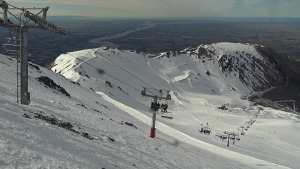TRANSFER Buyer’s Guide 2012 – Choosing the Right Snowboard
![]()

The author of the piece on a board that is about the right length! Photo Joey Corcoran.
Transfer Snowboard Magazine | Alex Cameron
What do you look for when you buy snowboards ? Everyone is different. Do you like rocker, camber or some combination of both? Do you like stiffer boards or softer boards? Or do you just choose based on the brand and the graphic? There is no correct way to choose a board, but some boards will be better suited to you and the way you ride so it is important to know what to look for when you stroll into your local shop.
The three most important considerations are:
Length
While length is ultimately a matter of personal preference, there is a fairly established rule for how long your snowboard should be. Generally the nose of a board should come up to about your chin when the tail is resting on the ground. Anything above your forehead or below your shoulders will make snowboarding more difficult. However in the past couple of years snowboard manufacturers have innovated new ways to make boards shorter; some of these boards break the conventional rules about length and still perform incredibly well. So speak to the people at your local snowboard shops to make sure you find the right length.
Rocker/Camber
These terms describe the board profile from end to end. To determine whether a board has rocker, camber or some combination of the two simply place it on a flat surface. Boards with rocker will only be touching the ground in the centre, and will rise up at the tip and tail. Boards with camber will be touching the ground near the tip and tail, and rise up uniformly through the middle of the board. There are two other less common profiles as well; combination boards will have more complicated profiles that are cambered in some areas and rockered in others, and flat boards are… well, flat. Board profile has perhaps the most significant impact on the performance of a snowboard. In general, cambered boards are more responsive so they are suited to the snowboarder who likes to ride groomed trails and varying snow conditions. Rocker snowboards are less responsive, but are the pick for riding powder. They are also better suited for beginner snowboarders because they are more maneuverable.

A graphical representation of different board templates.
Stiffness
There is a huge variation in snowboard stiffness between different brands and models. Again there is no right or wrong, only personal preference. If you’re someone who likes to ride the mountain, then as a general rule the stiffness of your board should increase with experience. Softer boards are more forgiving and therefore better suited to beginners, while stiffer boards perform better at high speeds and in varying snow conditions so they are better suited to advanced boarders. For the park rats, softer boards are better for riding boxes and rails, while stiffer boards are better for riding jumps and halfpipes. The most common test for board stiffness is to place one end of the snowboard on the carpet in the snowboard shop and hold the other end in both hands with the base of the snowboard facing away from you. Slowly press your knee into the middle of the board and feel how much it flexes. Softer boards will bend noticeably and can be held out of shape. Stiffer boards will not bend much and quickly snap back into their natural shape.

Nick Hyne and Will Jackaways watch on as Nick Brown flexes his board. Photo Vaughan Brookfield.
2012 Buyers Guide
Over 400 products for all your winter 2012 needs.
All the best brands.
Having the right gear is the key to a good time.




